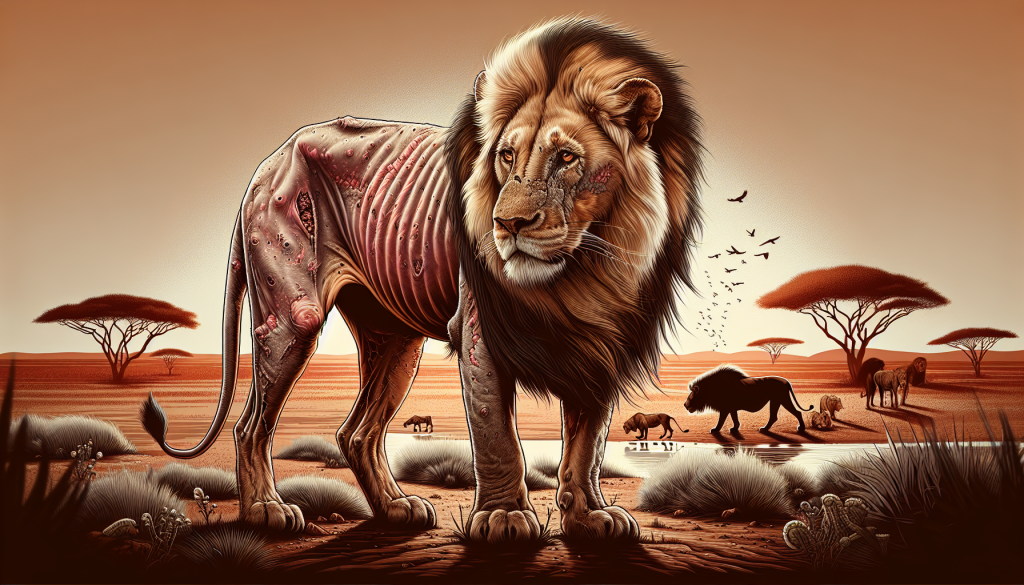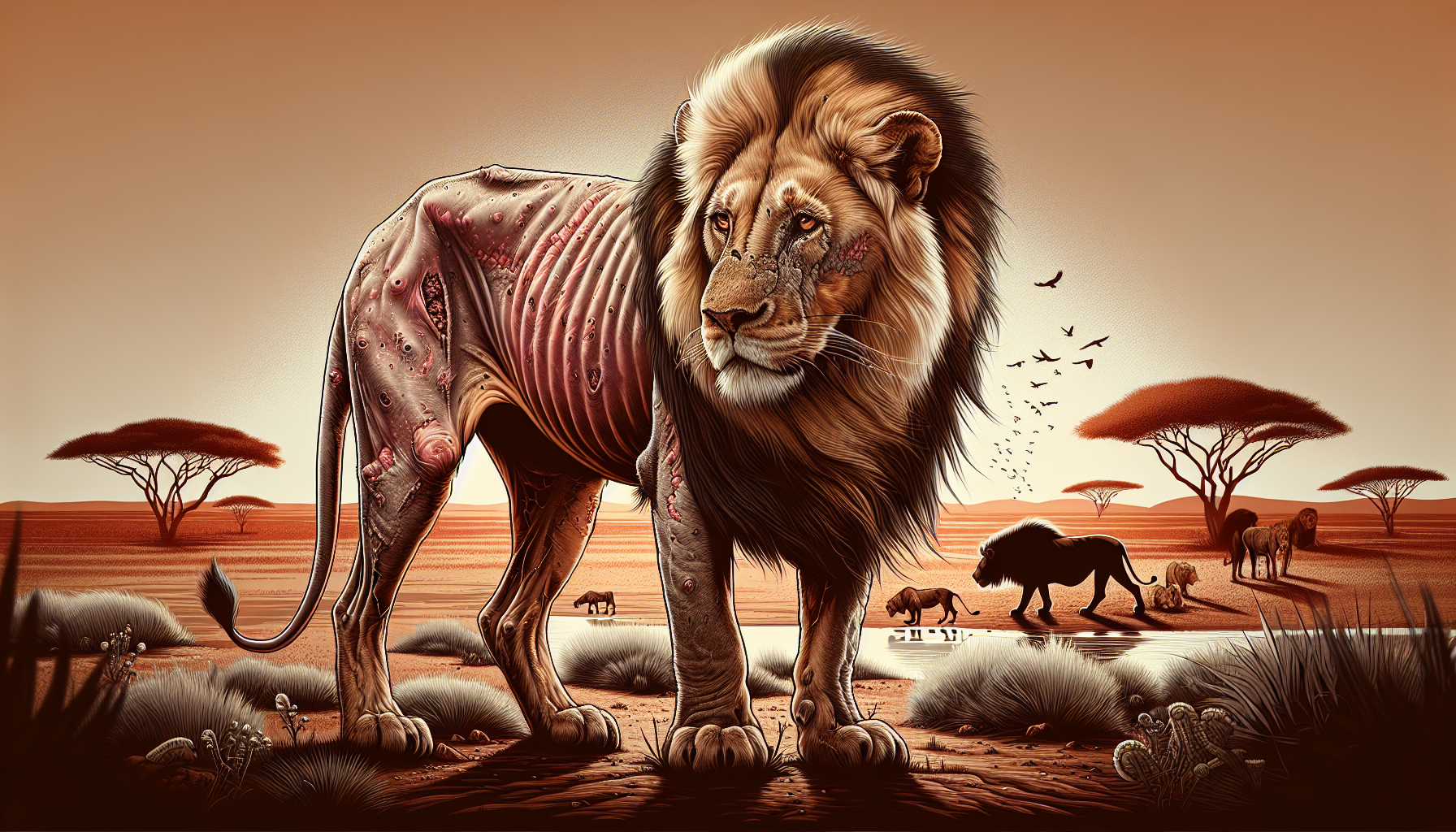Picture this: the mighty lions of the African savannah, their golden mane flowing in the wind, their powerful roars echoing through the open plains. These majestic creatures have long been symbols of strength and beauty. However, behind their regal exterior lies a hidden vulnerability – the impact of disease on their populations. In this article, we will explore the various diseases that threaten the survival of lions, examining the devastating consequences these illnesses have on these iconic creatures. Brace yourself for a journey into the heart of the wild, where the battle for survival is not only against nature but also against microscopic adversaries.
Introduction
Lions, often referred to as the kings of the jungle, are majestic creatures that have captured our imagination for centuries. With their regal mane and powerful stature, they are an iconic symbol of strength and beauty. However, these magnificent animals are facing numerous threats, and one of the most significant is disease. In this article, we will explore the various diseases that affect lions, their transmission, and the impact they have on population dynamics. We will also delve into the efforts being made to monitor and protect these vulnerable creatures.
Overview of Lions
Physical characteristics
Lions are large, muscular predators with a distinctive mane that is highly valued in their appearance. They vary in size depending on their sex, with males weighing between 330 and 550 pounds and females weighing between 250 and 400 pounds. The males’ impressive mane not only adds to their regal appearance but also serves as a sign of their dominance and reproductive fitness.
Habitat and distribution
Lions are primarily found in sub-Saharan Africa, although a small population exists in the Gir Forest in India. They inhabit various habitats, including savannas, grasslands, and semi-arid regions. These habitats provide the lions with ample prey and suitable conditions for breeding and raising their young.
Predators and prey
Despite being formidable predators, lions do face threats from other species. Hyenas, leopards, and other lions are known to prey on lion cubs, while larger herbivores like buffalo and elephants can pose a danger to adult lions. Lions primarily feed on large ungulates such as zebras, wildebeests, and antelopes, employing their exceptional hunting skills to capture their prey.
Conservation status
Lions are listed as vulnerable by the International Union for Conservation of Nature (IUCN) due to a significant decline in their population over the past few decades. Their declining numbers can be attributed to various factors, including habitat loss, poaching, and disease. By understanding the impact of disease on lion populations, we can better address the conservation challenges they face.

Disease Dynamics
Common diseases affecting lions
Lions are susceptible to a range of diseases, including viral, bacterial, parasitic, and vector-borne illnesses. Some of the common diseases affecting lions include Feline Immunodeficiency Virus (FIV), Feline Leukemia Virus (FeLV), Canine Distemper Virus (CDV), Tuberculosis, Brucellosis, Anthrax, Babesiosis, Toxoplasmosis, Sarcocystis, Trypanosomiasis (Sleeping sickness), Malaria, and more.
Transmission of diseases
Diseases can be transmitted through various means, including direct contact between infected and susceptible individuals, as well as through contaminated water sources, insect vectors, or infected prey. The close proximity and social behavior of lion prides make them particularly susceptible to disease outbreaks.
Impact on population dynamics
Diseases can have a significant impact on lion population dynamics. For instance, viral diseases like FIV and FeLV can weaken the lions’ immune system, making them more susceptible to other illnesses and reducing their overall fitness. Bacterial diseases such as tuberculosis and brucellosis can cause reproductive issues and lead to higher cub mortality rates. Parasitic diseases like babesiosis and toxoplasmosis can severely debilitate lions, affecting their ability to hunt and survive in the wild.
Viral Diseases
Feline Immunodeficiency Virus (FIV)
FIV is a lentivirus that attacks the immune system of lions, similar to the human immunodeficiency virus (HIV). It weakens the immune system, making lions more vulnerable to other infections. Transmission mainly occurs through bites during fights between males defending their territories.
Feline Leukemia Virus (FeLV)
FeLV is another viral disease that affects lions, causing various health issues. It can be transmitted through close contact, such as grooming or sharing food, among members of the lion pride. FeLV weakens the immune system, leading to increased susceptibility to infections and diseases.
Canine Distemper Virus (CDV)
CDV is a highly contagious viral disease that can affect a wide range of animals, including lions. Transmission occurs through contact with infected bodily fluids or respiratory droplets. CDV can cause respiratory, gastrointestinal, and neurological symptoms, eventually leading to death.

Bacterial Diseases
Tuberculosis
Tuberculosis is a bacterial disease that can affect lions, causing respiratory issues and general debilitation. It can be transmitted through inhalation of infected respiratory droplets or through the consumption of infected prey. Tuberculosis can have a severe impact on lion populations, leading to reduced fertility rates and increased cub mortality.
Brucellosis
Brucellosis is caused by the bacteria Brucella and can affect lions and other mammals. It is primarily transmitted through contact with infected bodily fluids. Brucellosis can lead to reproductive issues, such as abortions and stillbirths, in lions, further contributing to population decline.
Anthrax
Anthrax is a bacterial disease caused by the spore-forming bacterium Bacillus anthracis. Lions can contract anthrax through consumption of infected carcasses or contact with contaminated soil or water sources. Anthrax outbreaks can result in sudden and significant lion mortalities, posing a serious threat to population numbers.
Parasitic Diseases
Babesiosis
Babesiosis is a parasitic disease caused by protozoa of the genus Babesia. Lions can acquire babesiosis through the bite of infected ticks. This disease affects red blood cells, leading to anemia and other health complications. Severe cases can be fatal, especially in young cubs or individuals with compromised immune systems.
Toxoplasmosis
Toxoplasmosis is caused by the protozoan Toxoplasma gondii and can infect lions through the consumption of infected prey. Although most healthy adult lions can tolerate the infection, it can be dangerous for immunocompromised individuals and cubs. Toxoplasmosis can lead to severe neurological and reproductive issues.
Sarcocystis
Sarcocystis is a parasitic disease caused by the protozoan Sarcocystis spp. Lions can become infected by consuming prey that contains the parasite’s cysts. While many lions can tolerate low levels of infection, high parasite burdens can lead to health issues, including muscular and intestinal damage.

Vector-Borne Diseases
Trypanosomiasis (Sleeping sickness)
Trypanosomiasis, also known as Sleeping sickness, is a vector-borne disease caused by the parasite Trypanosoma. Lions can contract trypanosomiasis through the bite of infected tsetse flies. The disease affects the central nervous system, leading to neurological symptoms and ultimately death if left untreated.
Babesiosis
Babesiosis, mentioned previously as a parasitic disease, is also transmitted through ticks, which act as vectors. The parasite infects the red blood cells, causing anemia and other health complications. Regular monitoring and tick control measures are essential to prevent Babesiosis outbreaks in lion populations.
Malaria
Malaria, caused by the Plasmodium parasite, is transmitted through the bite of infected mosquitoes. While malaria primarily affects humans, there have been cases of malaria infections in lion populations. The impact of malaria on lions is not fully understood, but it poses a potential threat to their health and survival.
Impact on Reproduction
Reduced fertility rates
Diseases, particularly bacterial infections like tuberculosis and brucellosis, can lead to reduced fertility rates in lions. These reproductive issues affect the overall population growth and can contribute to declining numbers. Reduced fertility rates further exacerbate the challenges faced by lion populations.
Higher cub mortality
Diseases not only impact the reproductive success of lions but also contribute to higher cub mortality rates. Infected lionesses may have weakened immune systems, leading to reduced milk production and compromised nutrition for their cubs. Additionally, diseases like Babesiosis and toxoplasmosis can directly affect cub health, leading to higher mortality rates.

Population Decline and Extinction Risk
Decreasing lion populations
Lion populations have been declining at an alarming rate over the past few decades. Habitat loss due to human encroachment, poaching for trophies and body parts, and the impact of diseases have all contributed to this decline. The loss of lions from their natural habitats disrupts ecosystems, as they play a crucial role in maintaining healthy prey populations.
Contributors to population decline
While diseases alone do not account for the entirety of lion population decline, they are significant contributors to this downward trend. Disease outbreaks can decimate entire prides, leading to localized extinctions. The synergy between disease and other threats, such as habitat loss and poaching, further exacerbates the challenges faced by lions.
Extinction risk and conservation measures
With lion populations decreasing and their conservation status listed as vulnerable, there is a genuine risk of extinction if effective conservation measures are not implemented. Efforts such as protected area management, anti-poaching initiatives, habitat restoration, and disease monitoring and surveillance are crucial for ensuring the long-term survival of lions. Greater awareness and support for these conservation efforts are essential to protect these iconic creatures for future generations.
Current Efforts and Future Directions
Disease monitoring and surveillance
Monitoring and surveillance programs play a vital role in understanding the impact of diseases on lion populations. By tracking disease prevalence, identifying disease hotspots, and monitoring population dynamics, scientists and conservationists can develop targeted interventions and prevention strategies.
Vaccination and treatment programs
Efforts are underway to develop vaccines and treatments for diseases that affect lions. Vaccination programs can help reduce the incidence and severity of viral diseases like FIV and FeLV. Treatment options for bacterial and parasitic diseases are also being explored to mitigate their impact on lion health.
Conservation strategies to protect lions
Conservation organizations and governments are implementing various strategies to protect lion populations. These include strengthening protected areas, establishing wildlife corridors, raising awareness about the importance of lion conservation, and promoting responsible tourism practices. Collaboration between stakeholders, including local communities, is crucial for the success of conservation initiatives.
In conclusion, disease poses a significant threat to lions and their long-term survival. Viral, bacterial, parasitic, and vector-borne diseases can have devastating impacts on lion populations, leading to reduced fertility, higher cub mortality, and population decline. Efforts are being made to monitor, prevent, and treat these diseases, but a collective and comprehensive approach is required to safeguard the future of lions. By supporting conservation initiatives and raising awareness about the impact of diseases on lion populations, we can contribute to the preservation of these magnificent creatures and the ecosystems they call home.


